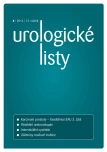EFFECT OF PDE5- I ON MEN’S SEXUAL HEALTH AFTER SPINAL TRAUMA
Authors:
I. Dolan; T. Šrámková; P. Řehořek; P. Filipenský
Published in:
Urol List 2014; 12(4): 29-32
Overview
Introduction:
Sexual dysfunction is a common consequence of spinal trauma. Treatment of sexual dysfunction is an important part of rehabilitation and resocialization of these patients and helps to improve their quality of life. Development of erectile dysfunction (ED) depends on the height of the injured segment of the spinal cord and the extent of the lesion. ED therapy currently provides a wide range of options, depending on the preference of the patient. Oral PDE5 inhibitors (PDE5-I) are the gold standard in the treatment of ED in men after spinal trauma, especially for its easy application and proven effect.
Material and methods:
We examined the influence of the use of PDE5- I on erection quality and frequency of sexual intercourse and non‑coital sexual activity in men after spinal trauma. The group consisted of 67 patients after spinal trauma aged 15– 60 years (mean age 36.5 years) followed up in the androurologic ambulance of University Hospital St. Anne. IIEF‑ 5 questionnaire and custom design were used. The autors used descriptive and inductive statistics using the Wilcoxon paired test (p < 0.05). Rate of return was 44% (30 questionnaires).
Results and conclusion:
Almost all men after spinal trauma in our sample (93%) suffer from erectile dysfunction. Only less than half of them (43%) were taking PDE5- I. We found a significant correlation between the use of PDE5- I and erection quality (p < 0.01). PDE5- I users have significantly higher frequency of sexual intercourse (p < 0.01) and non‑coital sexual activity. The wide range and frequent incidence of sexual dysfunction after spinal trauma requires an active approach of both urologist and andrologist.
Key words:
spinal trauma, erectile dysfunction, PDE5-I
Sources
1. Van Middendorp JJ, Hosman AJ, Donders AR et al. A clinical prediction rule for ambulation outcomes after traumatic spinal cord injury: a longitudinal cohort study. Lancet 2011; 377(9770): 1004– 1010. doi: 10.1016/ S0140‑ 6736(10)62276‑ 3.
2. Wyndaele M, Wyndaele JJ. Incidence, prevalence and epidemiology of spinal cord injury: what learns a worldwide literature survey? Spinal Cord 2006; 44(9): 523– 529.
3. Knútsdóttir S, Thórisdóttir H, Sigvaldason K et al.Epidemiology of traumatic spinal cord injuries in Iceland from 1975 to 2009. Spinal Cord 2012; 50(2): 123– 126. doi: 10.1038/ sc.2011.105.
4. Tator CH. Review of treatment trials in human spinal cord injury: issues, difficulties, and recommendations. Neurosurgery 2006; 59(5): 957– 982.
5. Espagnacq MF, Albert T, Boyer FC et al. Predictive factors of long‑term mortality of persons with tetraplegic spinal cord injury: an 11‑year French prospective study. Spinal Cord 2011; 49(6): 728– 735. doi: 10.1038/ sc.2010.189.
6. Strauss DJ, Devivo MJ, Paculdo DR et al. Trends in life expectancy after spinal cord injury. Arch Phys Med Rehabil 2006; 87(8): 1079– 1085.
7. Frankel HL, Coll JR, Charlifue SW et al. Long‑term survival in spinal cord injury: a fifty year investigation. Spinal Cord 1998; 36(4): 266– 274.
8. Yeo JD, Walsh J, Rutkowski S et al. Mortality following spinal cord injury. Spinal Cord 1998; 36(5): 329– 336.
9. Yang CC, Bradley WE. Peripheral distribution of the human dorsal nerve of the penis. J Urol 1998; 159(6): 1912– 1916.
10. Šrámková T. Posttraumatická sexuální dysfunkce u pacientů s transverzální míšní lézí. Urolog pro Praxi 2008; 9(6): 282– 286.
11. Breza J. Erektilné poruchy. 1. ed. Martin: Osveta 1994.
12. Šrámková T. Sexuologicko‑andrologické aspekty traumatických míšních lézí a kvalita života. Kandidátská dizertační práce. Brno 1998.
13. Anderson KD. Targeting recovery: priorities of the spinal cord‑ injured population. J Neurotrauma 2004; 21(10): 1371– 1383.
14. Valtonen K, Karlsson AK, Siösteen A et al. Satisfaction with sexual life among persons with traumatic spinal cord injury and meningomyelocele. Disabil Rehabil 2006; 28(16): 965– 976.
15. Dahlberg A, Alaranta HT, Kautiainen H, Kotila M. Sexual activity and satisfaction in men with traumatic spinal cord lesion. J Rehabil Med 2007; 39(2): 152– 155.
16. Sipski M, Alexander CJ, Gómez‑ Marín O. Effects of level and degree of spinal cord injury on male orgasm. Spinal Cord 2006; 44(12): 798– 804.
17. Wespes E, Eardley I, Giuliano F et al. Guidelines on male sexual dysfunction: Erectile dysfunction and premature ejaculation. EAU 2013. [online]. Available from: http:/ / www.uroweb.org/ gls/ pdf/ 14_Male%20Sexual%20Dysfunction_LR.pdf.[cit. 2014- 03-11].
18. Trojan O. Sildenafil v terapii erektilní dysfunkce. Med praxi 2013; 10(2): 57– 63.
19. Mittmann N, Craven BC, Gordon M et al. Erectile dysfunction in spinal cord injury: a cost‑utility analysis. J Rehabil Med 2005; 37(6): 358– 364.
20. Šrámková T. Poruchy sexuality u somaticky nemocných a jejich léčba. 1. ed. Praha: Grada Publishing 2013.
21. Zvěřina J. Lékařská sexuologie. Praha: Sexuologický ústav 1. LF UK 1994.
Labels
Paediatric urologist UrologyArticle was published in
Urological Journal

2014 Issue 4
Most read in this issue
- Interstitial cystitis / bladder pain syndrome – a primer and a world-view
- UPDATE ON LAPAROSCOPIC FISTULA SURGERY – OUR TECHNIQUE AND REVIEW OF THE LITERATURE
- RECONSTRUCTION OF BULBAR URETHRAL STRICTURES
- ADVANCES IN FLEXIBLE URETEROSCOPY – INDICATIONS, TECHNIQUES, AND MANAGEMENT OF COMPLICATIONS
